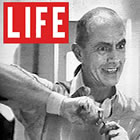
Dr. Charles Dotter in LIFE Magazine (1964)
Crazy Charlie. An August 1964 LIFE magazine photo spread on Dr. Charles Dotter reinforced that nickname, given to Dotter by the vascular surgeons who knew him and his work at Oregon Health Sciences University in Portland — and who did not like what he was doing. Unblocking arteries in the leg without surgery? From the inside, using catheters? Crazy!
So that was 50 years ago, and to call Dotter a visionary is a vast understatement because this week, radiologists, cardiologists and surgeons have gathered in Las Vegas, not to gamble (although who’s to say…) but to present and hear the latest information, late-breaking trials and reports on vascular interventional therapies at the VIVA 14 meeting and see demonstrations of an array of devices and techniques.
Dotter’s original vision was to open up blockages in the leg. As a radiologist, his job was to image these arteries using fluoroscopy, so that the vascular surgeons would know exactly where to operate. Imaging required threading a catheter into the arteries through a small puncture, and squirting dye. Dotter thought, “What if I just keep advancing the catheter up to the blockage itself, and then push it through, opening up the artery?” So he devised a system of catheters, starting with a very thin one. Each successive catheter was incrementally wider and could be advanced over the previous. His first attempt in an 82-year-old woman was very successful and resulted in saving her leg from amputation, without surgery. Crazy.
This week at the VIVA 14 meeting, participants are looking at balloons that are coated with drugs to keep the artery from reblocking, stents that work similarly and hold the artery open, atherectomy devices that shave the plaque and calcified material from the inside wall, sometimes followed by a balloon or stent. Kind of like prepping the surface of a wall before painting.
These devices are not just being used in the leg arteries, which are long and straight, but in the kidneys, in the aorta to repair life-threatening tears or treat aneurysms, in the carotid neck arteries to prevent strokes. And in many of these procedures, the catheter-based endovascular options have proven to be the equal of if not superior to open surgery.
Well, 50 years is a long time ago, you might say. But his ideas and techniques languished for almost two decades because, well, surgeons and doctors thought they were crazy. Not all of them. The list of the pioneers of interventional medicine is a testament to the perseverance of this dedicated group of physicians, who overcame skepticism, conducted rigorous studies to prove safety and efficacy, and to the companies that saw the future and began fashioning the necessary hardware. Cook Medical, in the person of Bill Cook, was the first to recognize Dotter’s genius. Others followed and today a very wide spectrum of devices and hardware exists.
To get a sense of Dotter and a brief look into his times, I’ve reposted the clip below from my blog earlier this year. The clip is a 6 minute excerpt from an earlier documentary of mine, “Explorers of the Heart (1985).” It’s introduced by Dr. Richard Myler and contains actual clips from a movie that Charles Dotter made and narrated about angioplasty (he was an amateur film-maker, among his many other talents)
You can follow the VIVA 14 meeting on Twitter at #vivapmd.



